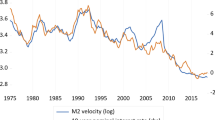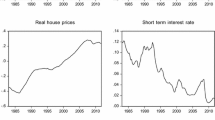Summary
In the Netherlands not much attention is paid to money supply figures as an indicator of actual monetary conditions. This can be partly explained by the publication lag and the continuous revisions of seasonally adjusted data. However, the information that can be derived from money supply figures is limited because of ‘temporary disturbances originating from the foreign exchange market. In this paper a correction method for these temporary disturbances is proposed. Money supply figures show a much closer link to real economic activity when corrected in this way.
Similar content being viewed by others
References
Barro, R.J. (1977), ‘Unanticipated Money Growth and Unemployment in the United States,’American Economic Review, 67, pp. 101–115.
Bomhoff, E.J. (1980),Inflation, the Quantity Theory, and Rational Expectations, Studies in Monetary Economics, Volume 5, Amsterdam.
Bomhoff, E.J. (1982), ‘De Prijs van de Staatsschuld en het Aanbod van Kapitaal,’ in:De Economie van het Aanbod, Preadviezen van de Vereniging voor de Staathuishoudkunde, Leiden/Antwerp.
Bomhoff, E.J. (1983),Monetary Uncertainty, Amsterdam.
Brunner, K. and A.H. Meltzer (1978),The Problem of Inflation, Amsterdam.
Butter, F.A.G. den (1981), ‘Monetaire transmissie,’ in: E. den Dunnen, M.M.G. Fase and A. Szász (eds),Zoeklicht op beleid, Leiden/Antwerp, pp. 83–109.
Fase, M.M.G. (1977), ‘Savings Deposits, Time Deposits and Interest Rate Differentials,’ De Nederlandsche Bank N.V., Reprint no. 34.
Fase, M.M.G. (1981), ‘Financiële Activa, Rentevorming en Monetaire Beheersbaarheid,’ in: E. den Dunnen, M.M.G. Fase and A. Szász (eds),Zoeklicht op beleid, Leiden/Antwerp, pp. 43-8l..
Kool, C.J.M. (1982), ‘The Multi-State-Kalman Filter Method,’ in: K. Brunner and A.H. Meltzer (eds),Economic Policy in a World of Change, Amsterdam.
Kool, C.J.M. and E.J. Bomhoff (1983), ‘Estimating Inflationary Uncertainty’ forthcoming.
Korteweg, P. (1978), ‘The Economics of Stagflation: Theory and Dutch Evidence,’Zeitschrift für die gesamte Staatswissenschaft, Band 135, Heft 4, pp. 553–583.
Korteweg, P. (1980), ‘Monetair beleid in Nederland (1) and (II),’Economisch-Statistische Berichten, 12-11-80, pp. 1256–1264, 19-11-80, pp. 1284–1291.
Krasker, W.S. (1980), ‘The “Peso Problem” in Testing the Efficiency of Forward Exchange Markets,’Journal of Monetary Economics, 6, pp. 269–276.
Mascaro, A. and A.H. Meltzer, (1983), ‘Long- and Short-term Interest Rates in a Risky World,’ to be published.
Nichols, D.A., D.H. Small and C.E. Webster jr. (1983), ‘Why Interest Rates Rise when an Unexpectedly Large Money Stock is Announced,’American Economic Review, 73, pp. 383–388.
Author information
Authors and Affiliations
Additional information
A different version of this essay with less emphasis on Holland but more information about other West-European countries has been published as chapter II “Watching the money supply” in: Eduard J. Bomhoff,Monetary Uncertainty, Amsterdam and New York, 1983. We gratefully acknowledge the able research assistance of Isolde B. Woittiez and Geert Rouwenhorst; Kempen and Co. kindly provided the two figures.
Rights and permissions
About this article
Cite this article
Bomhoff, E.J., Veugelers, P.T.W.M. Money creation and economic activity. De Economist 131, 498–516 (1983). https://doi.org/10.1007/BF02109407
Issue Date:
DOI: https://doi.org/10.1007/BF02109407




